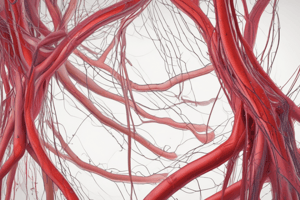Podcast
Questions and Answers
What is the primary function of precapillary sphincters?
What is the primary function of precapillary sphincters?
Which of these statements accurately describes fenestrated capillaries?
Which of these statements accurately describes fenestrated capillaries?
Which force is most responsible for the exchange of substances between blood and interstitial fluid?
Which force is most responsible for the exchange of substances between blood and interstitial fluid?
Which of the following factors contributes to higher peripheral resistance?
Which of the following factors contributes to higher peripheral resistance?
Signup and view all the answers
Which of these hormones contributes to increasing blood pressure?
Which of these hormones contributes to increasing blood pressure?
Signup and view all the answers
Which of the following is NOT a function of the innate immune system?
Which of the following is NOT a function of the innate immune system?
Signup and view all the answers
Which of the following is a primary lymphatic organ?
Which of the following is a primary lymphatic organ?
Signup and view all the answers
What is the main function of the lymphatic capillaries?
What is the main function of the lymphatic capillaries?
Signup and view all the answers
Which of the following accurately describes the flow of lymph drainage?
Which of the following accurately describes the flow of lymph drainage?
Signup and view all the answers
Which of the following is a function of the spleen?
Which of the following is a function of the spleen?
Signup and view all the answers
Which of the following is NOT a component of the first line of defense in the innate immune system?
Which of the following is NOT a component of the first line of defense in the innate immune system?
Signup and view all the answers
What is the significance of reticular connective tissue in lymph nodes?
What is the significance of reticular connective tissue in lymph nodes?
Signup and view all the answers
What component is missing from lymphatic follicles that prevents them from being classified as organs?
What component is missing from lymphatic follicles that prevents them from being classified as organs?
Signup and view all the answers
What is the primary function of the thoracic duct?
What is the primary function of the thoracic duct?
Signup and view all the answers
Which of the following best describes the role of the adaptive immune system?
Which of the following best describes the role of the adaptive immune system?
Signup and view all the answers
Study Notes
Blood Flow Regulation
- Precapillary Sphincters: Control blood flow through capillary beds. Open sphincters allow blood flow, while closed ones restrict it. Blood is directed to areas needing more nutrients via sympathetic (skeletal muscle) or parasympathetic nervous system (digestive system) activation.
Capillary Types
- Continuous Capillaries: No fenestrations; form the blood-brain barrier.
- Fenestrated Capillaries: Many small pores (fenestrations); found in kidneys for filtration.
- Sinusoids: Large fenestrations and intercellular clefts; in spleen and liver.
Capillary Exchange
- Mechanism: Movement of substances between blood and interstitial fluid.
- Driving Force: Primarily diffusion.
- Types of Diffusion: Filtration and reabsorption.
Venous Blood Flow
- Primary Driving Force: Skeletal muscle activity.
Blood Reservoir
- Largest Reservoir: Veins and venules.
Peripheral Resistance
- Definition: The force of opposition to blood flow within vessels.
Factors Influencing Peripheral Resistance
- Lumen Size: Inverse relationship—larger lumen, lower resistance.
- Blood Viscosity: Direct relationship—higher viscosity, higher resistance.
- Vessel Length: Direct relationship—longer vessels, higher resistance.
Blood Pressure Regulation
- Brain Structure: Medulla oblongata.
Hormonal Blood Pressure Regulation
- Renin-Angiotensin-Aldosterone System (RAAS): Increases blood pressure.
- Epinephrine/Norepinephrine: Change vessel diameter to decrease or increase blood pressure.
- Antidiuretic Hormone (ADH): Stimulates vasoconstriction, increasing blood pressure.
- Atrial Natriuretic Peptide (ANP): Decreases blood pressure.
Innate Immune System
First Line of Defense
- Skin acts as a physical barrier.
- Mucous membranes trap pathogens.
- Secreted fluids/chemicals (e.g., lysozyme) kill pathogens.
- Defecation and vomiting remove pathogens.
- pH control inhibits pathogen growth.
Second Line of Defense
- Natural killer (NK) cells destroy infected cells.
- Phagocytes engulf and destroy pathogens.
- Inflammation isolates and destroys pathogens.
- Fever inhibits pathogen growth.
Adaptive Immune System
- Mechanism: Specific defense developed over time, with memory.
- Purpose: Responds to pathogens already established.
- Key Feature: Vaccines target adaptive responses.
Lymphatic System
Lymphatic Capillaries
- One-way vessels that drain interstitial fluid into lymph nodes.
Lacteals
- Absorb dietary lipids from the digestive tract.
Terminal Vessels
- Thoracic Duct: Drains most of the body's lymph.
- Right Lymphatic Duct: Drains the right side of the body.
Lymphatic Organs
Primary Lymphatic Organs
- Red Bone Marrow: Produces B and T lymphocytes.
- Thymus: Site of T cell maturation.
Secondary Lymphatic Organs
- Lymphatic Follicles: Small patches of lymphoid tissue (tonsils, appendix, small intestine).
- Lymph Nodes: Filter lymph, activate immune cells.
- Spleen: Removes aged blood cells (both red and white).
Lymph Node Structure
- Reticular Connective Tissue: Traps pathogens and foreign materials.
Lymph Drainage and Metastasis
- Lymph drains proximally to the cancer source. Lymph nodes close to the tumor are sampled to check for metastasis.
Spleen Tissue
- White Pulp: Processes dead white blood cells.
- Red Pulp: Processes dead red blood cells.
Lymphatic Follicle Distinction
- Lack of Capsule: Lymphatic follicles are not considered true organs because they lack a capsule.
Studying That Suits You
Use AI to generate personalized quizzes and flashcards to suit your learning preferences.
Description
This quiz covers key concepts of blood flow regulation, focusing on precapillary sphincters and various capillary types. It explores mechanisms of capillary exchange and the role of venous blood flow. Perfect for students studying cardiovascular physiology.




